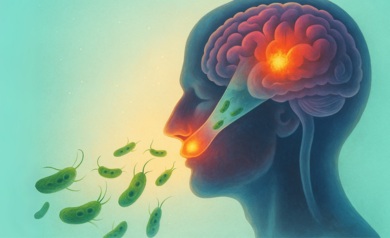- Health Conditions A-Z
- Health & Wellness
- Nutrition
- Fitness
- Health News
- Ayurveda
- Videos
- Medicine A-Z
- Parenting
- Web Stories
Ozzy Osbourne Parkinson's Diagnosis - Death Of The Heavy Metal Icon Highlights The Disease

Ozzy Osbourne, the legendary heavy metal artist passed away at 76 just a few weeks after his farewell show. Known for his contributions as the lead vocalist in the band Black Sabbath, Ozzy Osbourne was also dealing with the difficult diagnosis of Parkinson's. In 2020, during an interview with Good Morning America (GMA) the Grammy winner revealed that he had been diagnosed with Parkinson’s disease.
Assuring fans of his well-being, his wife Sharon Osbourne told the GMA audience that the diagnosis was not a “death sentence” but that he also had his good and bad days. Addressing his fans once again, the Osbourne family gave a joint statement conveying love to Ozzy and telling fans he passed among family members, surrounded with love.
Also Read: Neil Hopper, The Cornwall Doctor Charged With Fraud For His Own Leg Amputation For Insurance Claim
His death has put a spotlight on the disease, here is what you need to know.
What Is Parkinson’s: Signs, Cause, Risk Factors And Treatment
According to the National Health Service UK (NHS) Parkinson's disease is a brain condition that gets worse over many years. It slowly damages parts of your brain. The most common signs of Parkinson's disease are:
Shaking that you can't control (tremor)
This means parts of your body, like your hand, might shake without you wanting them to. It's often one of the first things people notice.
Slow movements
Everyday actions, like walking or getting dressed, start to take much longer. It's like your body is moving in slow motion.
Stiff muscles
Your muscles can feel rigid and hard to bend. This can make it difficult to move freely and can even cause pain.
Besides these main signs, people with Parkinson's can also have other problems. These might include feeling down or worried (depression and anxiety), having trouble with balance (which means you might fall more easily), losing your sense of smell, finding it hard to sleep, and even having some memory issues.
Causes
If you're worried you might have symptoms of Parkinson's disease, it's a good idea to see your family doctor (GP). Parkinson's disease happens because certain nerve cells in a part of your brain called the substantia nigra die off. These cells usually make a chemical called dopamine. Dopamine is really important for controlling your body's movements. When there's less dopamine, that's why you get the shaking, slowness, and stiffness.
Risk
Most people start to notice symptoms of Parkinson's disease when they are over 50 years old. However, some people can get it earlier, even before they turn 40. Also, men are a bit more likely to get Parkinson's disease than women.
Parkinson’s Treatment
Right now, there's no cure for Parkinson's disease. But there are treatments that can help manage the symptoms and keep you living as well as possible for as long as possible. These treatments include:
Supportive care: This means things like physiotherapy, which helps with movement, and occupational therapy, which helps with daily tasks.
Medication: There are medicines that can help control the symptoms.
Brain surgery: In some specific cases, surgery on the brain might be an option.
In the very early stages, your symptoms might be mild, and you might not need treatment right away. But your specialist will want to see you regularly to keep an eye on your condition.
What to Expect Over Time
As Parkinson's disease gets worse, the symptoms can become more severe, making it harder to do everyday things without help. Many people respond well to treatments and can live with only mild to moderate difficulties. However, a smaller number of people might not respond as well and could become more severely affected over time.
Parkinson's disease itself doesn't directly cause death. But it can put a lot of strain on your body and make you more likely to get serious infections. Good news is, with all the new treatments, most people with Parkinson's disease can now expect to live a normal or close-to-normal lifespan.n
Male Birth Control Pill Passes Early Safety Trials, Scientists Test New Contraceptive Without Side Effects

Credits: Canva
Male birth control pill might finally be here- the burden of birth control has disproportionately fallen on women. That may soon change. A groundbreaking experimental male birth control pill, YCT-529, has successfully passed its first human safety trial — without any significant side effects. The result marks a pivotal step toward giving men more contraceptive options beyond condoms or vasectomy.
Developed through a collaboration between the University of Minnesota, Columbia University, and biotech company YourChoice Therapeutics, YCT-529 is distinct from previous male contraceptive attempts because it is non-hormonal. That means it sidesteps the hormonal manipulation that often causes side effects in traditional contraceptives, making it a potentially safer and more acceptable option for widespread use.
Unlike female birth control pills that regulate estrogen and progesterone, YCT-529 works by targeting a specific protein known as retinoic acid receptor alpha. This protein, activated by vitamin A derivatives, plays a critical role in sperm production and maturation. The drug effectively blocks the receptor, halting sperm production without impacting other bodily systems.
“The innovation here lies in how precisely this pill works,” explained Dr. Gunda Georg, professor at the University of Minnesota’s College of Pharmacy. “We’re not interfering with the body’s hormonal balance, which is a huge step forward in terms of safety and user experience.”
How the Male Contraceptive Pill Works?
The experimental male birth control pill, known as YCT-529, targets a specific protein called retinoic acid receptor alpha (RAR-α)—a key player in sperm production. Normally, this receptor gets activated by a vitamin A derivative, which acts like a key turning on the body’s sperm-making machinery. YCT-529 blocks that key from fitting into the receptor, effectively shutting down the process.
By stopping this molecular interaction in the testes, the pill halts the formation and maturation of sperm. Scientists identified this mechanism by studying the receptor's structure and testing dozens of compounds to find one that could selectively block it.
In lab tests on male mice, the pill worked remarkably well. It brought sperm production to a halt within four weeks, was 99% effective at preventing pregnancy, and had no significant side effects. Importantly, the effects were reversible—mice regained fertility within four to six weeks after stopping the pill.
Unlike hormonal methods that can disrupt testosterone and cause mood or libido changes, this non-hormonal approach targets a specific biological pathway, making it a promising, low-risk alternative in male contraception research.
The initial preclinical testing in lab mice was promising: male mice treated with YCT-529 became temporarily infertile within four weeks. The drug had a 99% effectiveness rate in preventing pregnancy, and fertility rebounded four to six weeks after stopping treatment. Similar results were seen in nonhuman primates, where sperm counts dropped significantly but later recovered completely.
This encouraging data paved the way for a Phase 1 clinical trial involving 16 human volunteers aged 32 to 59 — all of whom had previously undergone vasectomies. This added layer of safety ensured that even in the event of unexpected long-term side effects, fertility would not be a concern.
Participants were divided into groups that received either a placebo, a low dose, or a high dose of the drug. Some took the pill on an empty stomach, while others took it after a meal to assess absorption differences.
No significant side effects were reported across any dose or condition. Heart rate, hormone levels, mood, inflammation, and sexual function all remained stable, a rare feat for early-stage contraceptive development.
While 16 people make for a strong safety signal, larger trials are needed to confirm YCT-529’s safety and, more importantly, its efficacy in real-world scenarios. Researchers are now moving ahead with longer studies involving daily use over 28 to 90 days. These new trials will monitor not just side effects, but changes in sperm count and motility, setting the stage for potential FDA approval.
Dr. Nadja Mannowetz, co-founder and chief science officer of YourChoice Therapeutics, emphasized that while the early data is encouraging, they're moving forward cautiously. “Our next trials will give us a much clearer picture of how this drug works in daily life — and whether it can become a reliable option for men everywhere.”
Currently, male contraception is stuck in the past. Only condoms and vasectomies are FDA-approved options for men, while women navigate a far more complex landscape of pills, patches, injections, implants, and IUDs — many of which come with long lists of side effects.
This imbalance has consequences. Nearly 75% of women say they believe both partners should be equally responsible for contraception, but the tools to support that belief simply don’t exist.
"A safe and effective male pill will provide more options to couples for birth control,” Dr. Georg noted. “It will allow a more equitable sharing of responsibility for family planning and provide reproductive autonomy for men.”
The journey to develop male contraception has been long and winding. Past attempts, particularly hormone-based options, stumbled due to low effectiveness or unpleasant side effects like mood swings, acne, or reduced libido. YCT-529 represents a dramatic departure from those efforts. By targeting the molecular machinery of sperm production, it gets the job done without compromising other bodily functions.
Still, hurdles remain. Even if the next stages of trials confirm its effectiveness, it could be years before YCT-529 is available to the public. Manufacturing, regulatory approval, public education, and access issues will all need to be addressed.
That said, the early buzz is unmistakable. Scientists are cautiously optimistic. Reproductive health advocates are hopeful. And couples around the world are watching closely.
This isn’t just about birth control. It’s about giving men agency over their reproductive choices, and relieving women of the disproportionate burden they’ve carried for decades. It’s about science catching up with society’s expectations.
As we enter a new era in contraceptive innovation, YCT-529 could become the first of many tools that give men a real seat at the table when it comes to family planning. The next phase of trials will tell us more. But for now, the signal is clear: male birth control is no longer science fiction. It’s becoming science fact and it’s arriving not a moment too soon.
Possible Hepatitis A Exposure At Popular Toronto Restaurant, Health Officials Warn Of Serious Threat

Credits: Canva
Toronto Public Health (TPH) has issued a health advisory following confirmation that patrons dining at Earls Kitchen + Bar on King Street West may have been exposed to Hepatitis A earlier this month. The possible exposure is linked to an employee at the 601 King Street W. location, who was diagnosed with the virus.
While Hepatitis A is uncommon in developed nations such as Canada, it is extremely infectious and can lead to inflammation of the liver, particularly among susceptible groups. Health authorities are now calling for individuals who ate at the restaurant during certain time periods to take precautions, keep watch for symptoms, and get vaccinated.
Toronto Public Health confirmed that the staff member infected with Hepatitis A was working during four specific shifts:
July 11: 4 p.m. to close
July 12: 4:30 p.m. to close
July 15: 4:30 p.m. to close
July 16: 7 p.m. to close
If you consumed food or beverages at this location during any of those dates and times, you may have been exposed to the virus. Officials stress that the risk is tied specifically to these timeframes and individuals.
Those who may have been affected are advised to wash their hands thoroughly and regularly, stay alert for symptoms, and get vaccinated within 14 days of possible exposure.
What Is Hepatitis A Infection?
Hepatitis A is a viral infection of the liver caused by the hepatitis A virus (HAV). It is spread through the fecal-oral route, usually when someone eats or drinks something that has been contaminated with the virus. Most often, this happens when an infected person frequently unknowingly prepares food without washing their hands.
Symptoms tend to occur anywhere from 15 to 50 days after becoming infected and can be either mild or severe. They are:
- Fever
- Fatigue
- Nausea or vomiting
- Loss of appetite
- Dark urine
- Stomach pain
- Jaundice (yellowing of the skin and eyes)
While most healthy individuals recover completely and gain lifelong immunity, the virus can cause serious complications for older adults and those with pre-existing liver conditions.
TPH Launches Free Vaccine At Clinics For the Exposed
To contain any potential outbreak and reduce the risk of illness, Toronto Public Health is offering free Hepatitis A vaccinations for anyone potentially exposed. Clinics are being held at Metro Hall (55 John St.) at the following times:
Friday: 4 p.m. – 7 p.m.
Saturday: 4 p.m. – 6:30 p.m.
The vaccine is most effective when administered within 14 days of exposure, which makes this intervention especially time-sensitive. Officials are urging anyone who visited Earls during the exposure windows to attend the clinic even if they are not currently experiencing symptoms.
People attending the clinic are advised to use the Wellington Street entrance for access.
Should You Avoid Eating at Restaurants?
Here’s the thing—there is no ongoing risk at the restaurant. Public health authorities have stated clearly that once the infected employee stopped working and sanitation measures were put in place, the immediate risk of infection evaporated. There’s no need to avoid the location now, provided proper precautions continue.
TPH is not advising the public to stop dining at the King Street Earls or any other locations. Instead, the focus is on post-exposure awareness and prevention.
How Hepatitis A Spreads Through Food?
Hepatitis A spreads primarily through the fecal-oral route, either by direct contact with an infected person or by consuming contaminated food or water. While foodborne outbreaks are relatively rare in countries like the U.S. and Canada, infected food handlers remain a frequent source of exposure. Improper hand hygiene during food preparation is a common culprit. Even when the source of infection isn't clearly identified, contaminated food is often suspected. Public health responses to such cases are resource-intensive, requiring swift contact tracing and vaccination efforts to prevent further spread.
This is why hand hygiene is key especially after using the bathroom, changing diapers, and before eating or preparing food. Public health agencies stress that ill individuals should not prepare food for others under any circumstance.
How To Prevent Hepatitis A Exposure?
In Canada, Hepatitis A is not included in the standard childhood immunization schedule. That’s because it isn’t widespread, largely due to the country's strong sanitation infrastructure. As a result, most Canadians lack natural immunity unless they’ve traveled abroad or specifically requested the vaccine but even if uncommon, isolated incidents like the one at Earls highlight how a single exposure can trigger large-scale health responses and the importance of proactive measures.
This incident underscores the broader implications for public health: a single lapse in hygiene can have ripple effects that stretch far beyond one restaurant or one infected employee. For food handlers:
- Wash hands thoroughly and frequently.
- Never handle food if feeling unwell.
- Follow proper food safety protocols.
For the general public:
- Be vigilant about handwashing, especially while traveling.
- Wash all fresh produce.
- Be cautious when consuming water or ice abroad.
And for those unsure about vaccination, especially frequent travellers, speak to your healthcare provider about the Hepatitis A vaccine. It might be a smart, preventive choice. Though most people infected with Hepatitis A recover fully, it’s not something to take lightly—especially given how stealthy and contagious it can be.
Brain-Eating Amoeba: What To Know About The Microscopic Killer That Took A 12-Year-Old Boy’s Life In Days

Credits: Health and me
Twelve-year-old Jaysen Carr was full of life until a summer day at Lake Murray, South Carolina, changed everything. Days after enjoying the water with his family, he developed symptoms that quickly escalated. Within a week, he was dead.
Doctors confirmed the reason as Naegleria fowleri, a rare and aggressive organism infamously dubbed the “brain-eating amoeba.” The South Carolina Department of Public Health and Prisma Health Richland Hospital in Columbia reported the pediatric death publicly on July 22. It's the first such case in the state since 2016.
The microscopic killer that claimed Jaysen’s life is a naturally occurring amoeba found in warm freshwater. It causes a deadly brain infection called primary amebic meningoencephalitis (PAM), which destroys brain tissue and is almost always fatal.
The Carr family, devastated by their sudden loss, is now seeking answers. Their attorney, Tyler Bailey, stated that while the family appreciates the outpouring of support from their community and the care provided by Prisma Health, they are committed to ensuring such a tragedy doesn't happen to another family.
"They have many questions about how and why Jaysen died," Bailey said in a public statement. “And they want to do everything in their power to make sure this doesn’t happen again.”
What Is a Brain-Eating Amoeba?
Naegleria fowleri is not actually “eating” your brain the way a parasite might devour tissue. But what it does is arguably worse. Once it enters the body—usually through the nose—it migrates to the brain, where it rapidly causes inflammation, swelling, and destruction of brain tissue.
This isn’t something you can catch from drinking water or shaking someone’s hand. It’s not contagious. You have to get water up your nose—typically during activities like swimming or diving in warm, untreated freshwater.
How Common Is Brain-Eating Amoeba?
That’s the strange part, for all its horror, Naegleria fowleri is incredibly rare.According to the CDC, only 167 cases have been reported in the U.S. over the last six decades. And of those, only four people have survived.
Despite this rarity, every summer it resurfaces in headlines because it tends to thrive in the very water bodies people flock to when temperatures rise—lakes, rivers, ponds, and hot springs, especially in Southern and Southwestern states like Texas and Florida.
In Jaysen’s case, the suspected exposure was Lake Murray, although health officials clarified that since the amoeba occurs naturally in many bodies of freshwater, pinpointing the exact source isn’t always possible.
What Causes Brain-Eating Amoeba?
Naegleria fowleri typically infects people when contaminated water enters the nose. Once inside, the amoeba travels along the olfactory nerve into the brain. That’s when things go downhill.
Initial symptoms appear within one to twelve days and may resemble meningitis or flu: headache, fever, nausea, vomiting, stiff neck. But very quickly, the infection escalates to confusion, seizures, hallucinations, coma—and then death. Death usually occurs within 5 to 10 days after symptoms begin.
Where Does Brain Eating Amoeba Come From?
Naegleria fowleri loves heat. It survives in water up to 115°F (46°C), which means late summer is prime time for activity. It’s found in:
- Warm lakes, ponds, and reservoirs
- Hot springs and geothermal waters
- Slow-flowing warm rivers
- Mud puddles and untreated wells
- Poorly maintained swimming pools or water parks
- Untreated municipal water supplies in rare cases
It cannot survive in saltwater, nor in properly chlorinated pools. And again, you can’t get infected by drinking contaminated water—only if it goes up your nose.
How To Avoid Brain-Eating Amoeba?
There is no vaccine or guaranteed treatment for Naegleria fowleri. So prevention is the best—and only—defense. Here’s what health experts suggest:
- Avoid freshwater activities, especially in warm, still water during the summer.
- Hold your nose or use nose clips when swimming or diving in lakes and rivers.
- Avoid stirring up sediment where the amoeba may live.
- Stay away from untreated splash pads and recreational water parks with unclear sanitation practices.
- Never use tap water to rinse your sinuses or fill neti pots unless it’s been properly boiled, distilled, or filtered with a 1-micron filter.
- Even if risk is low, it’s not zero—especially when the result of infection is nearly always fatal.
Why Is Brain-Eating Amoeba So Hard to Treat?
Once symptoms begin, treatment options are limited. The infection progresses too rapidly for most medications to have an effect. Some experimental treatments using antifungal drugs and hypothermia (lowering body temperature to reduce inflammation) have been used in a few survivors. But survival still depends heavily on early diagnosis, which is challenging because early symptoms mimic other common illnesses.
Has There Been Any Survivor Of Brain Eating Amoeba?
In 2024, 14-year-old Afnan Jasim from Kerala, India, stunned doctors by surviving PAM. His case was one of the very few globally where the infection was caught early enough, and an aggressive combination of treatments including antifungal and antibacterial medications, supportive care, and cooling therapies—was able to halt the amoeba’s advance.
Health officials urge calm and reiterate that the risk to the general public is extremely low but for parents, educators, and communities especially those in warmer regions—it’s a time to pay attention.
© 2024 Bennett, Coleman & Company Limited

